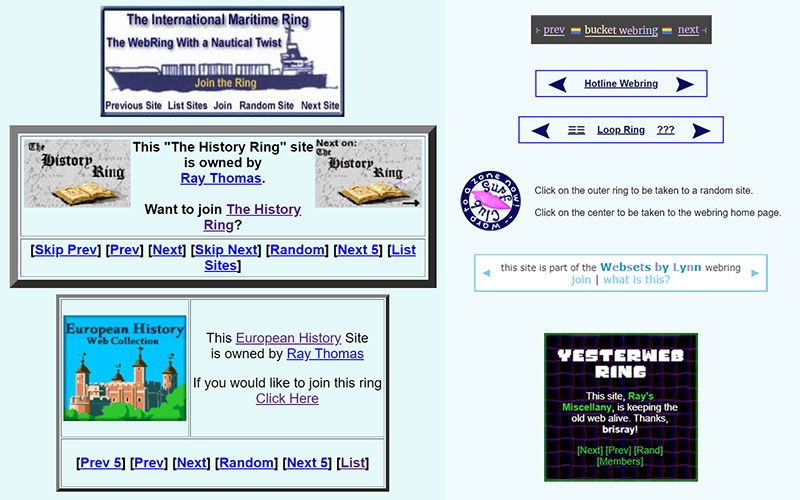Introduction
The heyday of webrings lasted from around 1996 until 2017. An interesting graph on Revisiting Web Rings by Andy Jackson, shows webring usage rising steeply from 1996 to 2001 then gradually dropping off. The larger webrings systems such as WebRing, Ringlink, RingSurf, and the others managed swathes of webrings using mostly proprietary software and databases. These systems have all but gone and the trend today is for indiviual webring owners to administer their own ring on their own computers. This page takes a look at some of the available webring systems and software and my own suggestions at what an ideal webring should offer.
How they work
The large webring system would host tens of thousands of webrings. Webring in January 2000, hosted 80,000 webrings. As these large sytems ended in around 1017, they were replaced by single webring administrators but they still functioned in the same way.
A website owner would find a webring they liked, or want to create one of their own. They would apply to to the system administrators or they could download the management software and administer it themselves. New members to the webring would apply to join and if accepted, be gven a slug of code to add to their website. Once the code was added they were then full members of the webring.

Examples of old and new webring links.
The newer links are generally smaller and more customizable
People would ask to join a webring and they would, if accepted, be given a ring identifier, a unique identifier for their site in the ring, the images, and the code to be placed on one of their pages. There were a variety of methods used to display the images and links. Bravenet's Sitering used an image map, Ringsurf used tables and Webring used either a JavaScript snippet or a table at different times. Some used an iframe where the content was served from the ringmaster's site.
Some ring managers would insist that the webring code be placed on the homepage, others would allow them to be placed on a "web ring" or links page.
Newer Systems
The days of the large, multiple webring management systems appears to be over, at least for the time being. The newer webring management software are best suited to single webrings.
20m
 20m is a web host that offers a webring system. The system looks very similar to the Perl Ringlink system but is very slow. I am not sure that the system is working as although there are many webrings, most only contain 1 site and many of those have very little, if any, content or cannot be reaached.
20m is a web host that offers a webring system. The system looks very similar to the Perl Ringlink system but is very slow. I am not sure that the system is working as although there are many webrings, most only contain 1 site and many of those have very little, if any, content or cannot be reaached.
Baccyflap's RMF PHP Webrings
Baccyflap's RMF PHP Webring code was written in the summer of 2024.
Constellation
Constellation is a webring system created by Erika Rowland (erikareads) using Gleam and associated technologies. It was published on March 31, 2024.
Faery-ring
Faery-ring appeared in 2022 and is written by Ember or Emi as they are also known by. It a non-JavaScript server-side single ring manager that requires Linux or Docker. It is published with dual CNPL Nonviolent Public License and FAFOL (Fuck Around and Find Out License) licenses.
Ikon
For want for a better name, Ikon's (Miss Elaney) webring code was published in April 2023. It uses JavaScript and a Google Spreadheet to work. Globlin Ring! and Meat Ring appear to both use the code on Comic Fury but neither seem to have a join page. One webring that does, or did when I wrote this, is the Aetherweave Webring.
June's Webstring JS
June's Webstring JS is a super simple JavaScript script. Absolutely everything is contained within a single file, for ease of editing & use. It's compact: not counting the settings object, the code is only 8 lines long. The page has a wizard to help configure the CSS for it and add other options.
LibreRing
 LibreRing is a JavaScript single webring management system that appeared in March 2023. The script was written by Lian B. and published under the GNU Lesser General Public License.
LibreRing is a JavaScript single webring management system that appeared in March 2023. The script was written by Lian B. and published under the GNU Lesser General Public License.
Linkcircle
 Linkcircle is a JavaScript driven webring utility. Linkcircle was written by Dabric and published on May 19, 2023.
Linkcircle is a JavaScript driven webring utility. Linkcircle was written by Dabric and published on May 19, 2023.
Onionring
Onionring first appeared at the end of 2000 and is a JavaScript single webring management system hosted by Garlic Garden. It is the most popular script for creating a webring. It is published under the Cooperative Non-violent license (CNPL) v4+ license.
GitHub Repositories
GitHub has become the repository of choice for many software developers. I should mention something about the licensing of this software. Derek Jones explains Github's licensing agreement in the absence of any others with the code in his article "The Truth About the Risks of Unlicensed Software", and GitHub's Terms of Service.
How many of the webring managers work on GitHub is that the potential webring member adds the webring code snippet to their own site, then creates a fork (makes a copy) of the main code and adds their site details to the list of sites in a file in the fork and then asks for the fork to be merged intoto the main repository. The ring manager then inspects the new site and the fork and if acceptable merges the files into their code.
The code snippet placed on the new member's page usually contains a link to a JavaScript file, that reads the file contains the list of members and inserts the webring links on their page, as well as any images and CSS that are needed. Alternatively, the processing is done on GitHub or the ringmaster's own site and inserted into an iframe on the member's page. The member list file is usually a plain text file, to make it easy for the member to edit, and can be in a variety of formats; JSON, CSV, XML, RDF, HTML etc.
Where possible to determine them, I have only included the originating source repository. The number of forks is a little misleading as they do not represent members of the orignal webring or that they used to create a new one. It seems many were made and then not used at all rather than being simply deleted.
The following repositories are the most forked and run a variety of webrings:
 Brob Netlify Webring - A lambda function for creating a webring on Netlify. 28 forks (January 2023)
Brob Netlify Webring - A lambda function for creating a webring on Netlify. 28 forks (January 2023)
iceconey14 as well as creating their own webrings has created several webring systems. These include phpringring which is compatible with mysql, mongodb, sqlite, or postgresql and serversidering which has variations written in asp, coldfusion, jsp, perl and php.
ringfairy - A webring generator written in Rust by Kern. The code produces pre-generated static HTML files. The code was first written in January 2024, and has a GPL-3.0 license.
Maxboeck Webring - Members are added by editing a JSON file and the member code includes a JaveScript file. This has an MIT license. 184 forks (January 2023)
Oring - Members are added by editing a JSON file and the member code includes a JaveScript file. This has an GNU General Public License.
Webring-Starter - A webring code by Bill Hunt. The code uses Jekyll as a static site and a few lines of JavaScript need to be added to member sites. The code can also provide members Atom or RSS feeds. This has an MIT license.
RainRing
 RainRing is a simple, lightweight HTML and JavaScript webring code by Rainbow Cemetery.
RainRing is a simple, lightweight HTML and JavaScript webring code by Rainbow Cemetery.
Smallweb Subway
 Smallweb Subway was written using JavaScript by Gus Becker in November 2023. The code is available on Github.
Smallweb Subway was written using JavaScript by Gus Becker in November 2023. The code is available on Github.
Viatrix (mincerafter42)
 Viatrix is the ringmaster of the Cuddler Webring and created their own code to do it. The code has several dependancies and needs user accounts on both Github abd Netlify. The code is on GitHub as cuddler-webring and the code has been used to create other webrings.
Viatrix is the ringmaster of the Cuddler Webring and created their own code to do it. The code has several dependancies and needs user accounts on both Github abd Netlify. The code is on GitHub as cuddler-webring and the code has been used to create other webrings.
Webring.gg
 Webring.gg is a webring management system. Written with Django Server-Side Rendering (SSR), it first appeared in February 2024, but not fully working until March 2025.
Webring.gg is a webring management system. Written with Django Server-Side Rendering (SSR), it first appeared in February 2024, but not fully working until March 2025.
Webri.ng
Webri.ng is one of the few multi-ring management systems around and first appeared in 2022. It uses an SQL database and the source code is available on GitHub.
Older Systems
Although these are older codes there is no reason why they cannot be utilized as many of them were published with GNU General Public Licenses. After these were first written they were managing thousands of webrings. Where possible I have made the scripts available for download from my server, but please remember to read the original sites for usage and licensing, even if they do come from the Intnernet Archive. I cannot offer any sort of support for any of them.
Basingstoke Roundabout
 The Basingstoke Roundabout Webring Script was written by E. P.J "Joe" Tozer in 1999. It is a simple, lightweight HTML and JavaScript webring code. Joe Tozer retains the copyright to the files, but the documentation allows use of the slightly modified files. The files are available for download from Joe Tozer's site and also available here. Download (ZIP, 47Kb)
The Basingstoke Roundabout Webring Script was written by E. P.J "Joe" Tozer in 1999. It is a simple, lightweight HTML and JavaScript webring code. Joe Tozer retains the copyright to the files, but the documentation allows use of the slightly modified files. The files are available for download from Joe Tozer's site and also available here. Download (ZIP, 47Kb)
Draupnir Ringmanager
 Draupnir Ringmanager was a webring manager written in PHP as a WordPress plugin. It first appeared in 2014, and was last updated in 2015, meaning it is now (February 2023) 3 releases behind WordPress. The files are available for download from the WordPress site and also available here. Download (ZIP, 22Kb)
Draupnir Ringmanager was a webring manager written in PHP as a WordPress plugin. It first appeared in 2014, and was last updated in 2015, meaning it is now (February 2023) 3 releases behind WordPress. The files are available for download from the WordPress site and also available here. Download (ZIP, 22Kb)
FS Rings
 FS Rings (Internet Archive) was a short-lived system that ran from 2003 to 2004. It was written in PHP with MySQL database. The source code is available on SourceForge and also available here. Download (ZIP, 76Kb)
FS Rings (Internet Archive) was a short-lived system that ran from 2003 to 2004. It was written in PHP with MySQL database. The source code is available on SourceForge and also available here. Download (ZIP, 76Kb)
Neorings
 Neorings is the dedicated platform for webmasters of the oldweb to host and connect their pages to webrings. Neorings was created in November 2023, but disappeared in June 2024, taking all 21 rings that used it. Because of the way it was coded, the Internet Archive could not archive the list of rings.
Neorings is the dedicated platform for webmasters of the oldweb to host and connect their pages to webrings. Neorings was created in November 2023, but disappeared in June 2024, taking all 21 rings that used it. Because of the way it was coded, the Internet Archive could not archive the list of rings.
NetRing Server
NetRing Server (Internet Archive) appeared in 2001 and was advertised as more feature-rich than RingSurf, Bravenet and Yahoo! It was a complete ring management system written in Perl by Perl Producers Inc. The program was free and published with a GNU Public License but there may have been a problem with the software at it was not available for download after 2002. I cannot find a downloadable version of the software (January 2023)
Orca Ringmaker
 Orca Ringmaker was a PHP script for managing webrings and used a MySQL database. It was written by Brian Huisman (GreyWyvern) in 2005 and was still maintained until version 3.0 in 2016. The page was still there in January 2023 but the program not offered for download because as Brian say's on the page "The Ringmaker script has aged badly." One of the problems with Orca was that is was vulnerable to SQL injection attacks that could compromise the database. It appears to have been caused because the script did not sanitize the user input before creating a databse SQL query. Like Ringlink it was published under the GNU General Public License.
Orca Ringmaker was a PHP script for managing webrings and used a MySQL database. It was written by Brian Huisman (GreyWyvern) in 2005 and was still maintained until version 3.0 in 2016. The page was still there in January 2023 but the program not offered for download because as Brian say's on the page "The Ringmaker script has aged badly." One of the problems with Orca was that is was vulnerable to SQL injection attacks that could compromise the database. It appears to have been caused because the script did not sanitize the user input before creating a databse SQL query. Like Ringlink it was published under the GNU General Public License.
As far as I can tell, Orca could be updated with user input sanitation and hashing the passwords in the database with SHA-2. Version 3.0 of Orca Ringmaker is still available from the Internet Archive and also available here, but please be aware of the security concerns with this script. Download (ZIP, 130Kb)
PHP-Ring
 PHP-Ring (Internet Archive) was a webring system written by Plebius Press in PHP 4 and used an SQL database in 2004. It was released under the GNU-General Public License and is still available for download from the Internet Archive link and also available here. Download (ZIP, 54Kb)
PHP-Ring (Internet Archive) was a webring system written by Plebius Press in PHP 4 and used an SQL database in 2004. It was released under the GNU-General Public License and is still available for download from the Internet Archive link and also available here. Download (ZIP, 54Kb)
Ringlink
![]()
 RingLink here and here (both links to the Internet Archive) was written in Perl by Gunnar Hjalmarsson in 2000. Version 3.3 (Internet Archive) was made available on the site in 2009, shortly after which the site closed down. Gunnar published it under the GNU General Public License. Several webring systems such as (alt)webring (Internet Archive), CrickRock (Internet Archive), Lord of the Rings (LOR)(Internet Archive), Page-Ring (Internet Archive), Stardust (Internet Archive), and Web Ring System (Internet Archive) used Ringlink to manage their webrings. Gunnar published the code to version 3.4 on SourceForge and it is still there in January 2023. It is also available here. Download (ZIP, 324Kb)
RingLink here and here (both links to the Internet Archive) was written in Perl by Gunnar Hjalmarsson in 2000. Version 3.3 (Internet Archive) was made available on the site in 2009, shortly after which the site closed down. Gunnar published it under the GNU General Public License. Several webring systems such as (alt)webring (Internet Archive), CrickRock (Internet Archive), Lord of the Rings (LOR)(Internet Archive), Page-Ring (Internet Archive), Stardust (Internet Archive), and Web Ring System (Internet Archive) used Ringlink to manage their webrings. Gunnar published the code to version 3.4 on SourceForge and it is still there in January 2023. It is also available here. Download (ZIP, 324Kb)
Some ring masters also decided to use Gunnar's code and host it themselves. One such was the author of Anvilfire, a blacksmithing and metalworking resource. They ran five webrings using Webring run by Yahoo!. In 2000, they became disillusioned with Yahoo! and started using Gunnar's Ringlink. Their webring page is still up (July 2023) but seems to have been inactive since 2008.
Ring World

 Ring World (Internet Archive) was commercial software that appeared in 1998 copyrighted by T&D Systems (Internet Archive) and TRXX Programming Group (Internet Archive). The two goups shared a common URL so they were probably the same. The scripts were available in several versions; Perl, Perl + SQL and PHP + SQL. The scripts were being sold at somewhere between $50 and $200 depending on version and year. However, by 2011, T&D Systems (Internet Archive) were offering the Perl + SQL version for free under the GNU General Public License. The download is still available from that Internet Archive site and is also available here. Download (ZIP, 109Kb)
Ring World (Internet Archive) was commercial software that appeared in 1998 copyrighted by T&D Systems (Internet Archive) and TRXX Programming Group (Internet Archive). The two goups shared a common URL so they were probably the same. The scripts were available in several versions; Perl, Perl + SQL and PHP + SQL. The scripts were being sold at somewhere between $50 and $200 depending on version and year. However, by 2011, T&D Systems (Internet Archive) were offering the Perl + SQL version for free under the GNU General Public License. The download is still available from that Internet Archive site and is also available here. Download (ZIP, 109Kb)
Simple PHP Website Ring Script
 Simple PHP Website Ring Script was written using PHP in 2002 by G. Dotzel and last updated in 2015. The code is freeware and available for download. It is used to run the Modula-2 webring.
Simple PHP Website Ring Script was written using PHP in 2002 by G. Dotzel and last updated in 2015. The code is freeware and available for download. It is used to run the Modula-2 webring.
SimpleRing
 SimpleRing (Internet Archive) was commercial webring software and not released to the public under one of the copyleft licenses. SimpleRing was a CGI Perl program and appeared on the PerlCoders site in 2001. Membership to PerlCoders cost $175, and the CGI Perl program SimpleRing was free to members but others had to pay $100 for the program. I have not been able to find any freely available copy of it (January 2003)
SimpleRing (Internet Archive) was commercial webring software and not released to the public under one of the copyleft licenses. SimpleRing was a CGI Perl program and appeared on the PerlCoders site in 2001. Membership to PerlCoders cost $175, and the CGI Perl program SimpleRing was free to members but others had to pay $100 for the program. I have not been able to find any freely available copy of it (January 2003)
SourceForge
In the early 2000s, some programmers thought they would have a go at developing the code to manage rings and some of those were put on the SourcceForge software repository and in January 2023, several are still there.
PHP My Ring was a self-hosted system written in PHP and using a MySQL database. It appeared on November 24, 2002 and the last version was made in May 2005.
PHP Webring was a self-hosted system written in PHP and using a MySQL database. It appeared on November 25, 2000 and last updated in January 2002.
PHPRing was a self-hosted system written in PHP and using a MySQL database. It appeared on December 14, 2000 and last updated in January 2001.
Martin Webb's JavaScript Webring Manager
Martin Webb posted his JavaSript code for managing webrings on the Internet Relatd Technologies website, IRT.org on May 9, 1998. There appears to be just one problem with the code and that is that it required the site owner to put an iframe on their website to contain the webring code and back then browsers had their own methods of dealing with them.
Alternatives
Surfle
Surfle was written by Billy Wilcosky in May 2024, and is a cross between a web diretory and a webring where the links are delivered via a browser extension. The code is on GitHub.
Gaining Members
Creating a webring is easy, gaining members for it is the hard part. Towards the end of 1998, Joachim Verhagen created the Science Humor Webring and wrote about his experience in running it, the various companies that hosted it and how he set about gaining members for the ring.
What Joachim did to find sites that would fit the webring and contact them via email or just advertise the ring, was not much different than what would be done today. He used search engines, directories and newsgroups, but today things like the main social media groups and aggregators could be used. The huge webring systems are gone, so individual rings can no longer be found using that method but webring lists do exist such as mine and the one mainained by foreverliketh.is and we are always happy to list new ones.
One thing that Joachim did that is unusual was to add a "Nominate a Site" form to his site. He would then contact the owner of the site to ask if they would like to join the ring.
You can always mention the webring in a post on places such as 32bit Cafe, Hacker News, Melonland, and Reddit. I check all of these, but you can always contact me, I'll add it to the webring list I keep.
Oh! The Humanity
For all the technology behind websites and webrings in particular, we're are all human and there should be at least an occasional communication between the ring master and their members. This is just my personal preference. it irritates me when a ring master in the webrings I belong to changes the code or shuts it down without saying anything.
Monetization
There have only been a couple of serious attempts to monetize webrings. On September 26, 2006, Webring Inc. announced a new WebRing Premium Membership Program. They have separated memberships into two types, WebRing 1.0 and WebRing 2.0. Sites that are part of WebRing 1.0 will be limited to 50 webrings per URL. Existing 1.0 members can maintain more than 50, but can not add more.
In conjunction with the premium membership program, WebRing introduced an affiliate program, in which webmasters earn money when others join webrings from their site; they earn an additional payment if the new member purchases a premium membership.
Much of the webring codes around were proprietary and not released to the public. Some was specifically released under one of the copyleft licenses. There was a third category of software that was written to be sold. In 2003, membership to PerlCoders (Internet Archive) cost $175, and the CGI Perl program SimpleRing was free to members but others had to pay $100 for the program.
Creating a Webring
If you are thinking of creating a webring you need to think about what sort of sites you want to admit to it and what the range is going to be. Suppose you decide you want to create a programming ring. Do you include all languages? Sites where there's just a page about the subject? Sites that have some Not Safe for Work (NSFW) pages? Will you accept any commercial sites?
Some Thoughts on a Webring Management System
Webring Homepage
Every now and then people ponder on webrings and how they could be reinvented. Among them are CSS-Tricks
In order to entice people to join your webring the webring homepage should contain a few items:
A brief descripton of what a webring is and how they work.
A brief descripton of your webring and what its purpose is.
Your requitements to join the webring, and what they need to do to maintain their status as a ring member.
A working example of the webring code.
A brief description of what each of the buttons/links do.
The instructions on how the user gets the code/images to put on their page - copy/paste, emailed to them etc.
Perhaps a FAQ.
Webring Code Links
At a very minimum the webring code needs to give the member plain links/images/icons showing:
Name-of-webring; Previous-site; Ring-hub; Next-site
Name-of-webring could be an image, logo, or button with a link to the ring hub.
There are other link that could be added, depending on how sophisticated you want to get:
Skip-x-sites-back; List-sites; Random-site; Skip-x-sites-forward
What are these links going to look like? Perhaps several designs should be made available; a minimalist one, something like the old webring links and something in between. The ringmaster will want to use their own images; what sizes should they be?
A Webring Manager
I am a great fan self-hosting and computer automation. These are my thoughts on how a webring manager could work. The code to do this can be written in whatever language the ringmaster is comfortable with, Perl, PHP, Python etc.
On the backend, while the number rings and their membership is small then it does not matter if the records are kept in plain text flat files such as JSON, CSV, XML, RDF etc., but if it is envisioned the number of rings and their members will run into thousands then an SQL database should be considered as they will be faster to query and process. A little old, but Stack Overflow discusses the pros and cons of both approaches.
Whichever is chosen, the code must be capable of generating at least the previous, next and random site links. It is obvious that the first and last in the list are going to take a little consideration to ensure the code can jump from the beginning to the end or vice versa.
Joining
A form on the webring home asks the potential member for some details about themselves and the site. The form should make it clear which webring the user is joining. This is important where the ringmaster manages multiple rings. The form could include:
Username - can the system cope with different users having the same username so long as the passwords are different?
Password - what is the minimum level of complexity needed?
Retype password - to help prevent typing errors
User Email - so the user can ringmaster can be contacted
Site Name
Site Description - max of 100 characters?
Site URL
Site webring landing page if different from the homepage
Some sort of authentication to prevent bot usage - CAPTCHA or reCAPTCHA
Validation and Santitization
The form must be both validated and santitized. Don't try to sanitize input. Escape output is an easy to read article by Ben Hoyt to explain the difference. The PHP-based Orca Ringmaker did not do this properly and penetration testers found the database could be compromised.
Once the form is submitted the inputs should be checked again and an email sent to both the ringmaster and member to confirm it has been sent and received.
At least the password field should be saved as a hash. The Open Web Application Security Project has a series of cheat sheets to help with security problems and fixes.
The ringmaster should actually visit the applicant's site to ensure the code has been added properly, whether it be via JavaScript, an iframe or another mechanism, and works.
Using their username and password, the member should be able to edit or even remove their pages from the webring. An email could be sent to confirm the changes have been made.
List Order
The order of the sites in the ring list should be considered. The sites can be listed in the order of joining the ring. What this means is that the previous and next links for everyone are going to be the same whenever a visitor clicks on them. The Rail had a different approach and randomized the list order every two weeks.
This should be considered because visitors are going to arrive at a site in the ring more or less randomly. However, some sites are going to be generally more popular than others, and it is those sites that are going to be sending more traffic to the ring. By randomizing the list order sites that are deserving of receiving more visitors but who have less Search Engine Optimization "juice" stand an equal chance of receiving visitors from the ring links.
Clentside Technology
How should people joing the ring put the code on their web pages?
What historically happened was that people wanting to join a ring from one of the larger webring managers would be given a be given a ring identifier, a unique identifier for their site in the ring, the images, and the code to be placed on one of their pages. There were a variety of methods used to display the images and links. Bravenet's Sitering used an image map, Ringsurf used tables and Webring used either a JavaScript snippet or a table at different times. Some used an iframe where the content was served from the ringmaster's site.
Technology and attitudes change but some things remain the same. The web client still has to communicate with the ringmater's site so the previous, next and random links can be generated. Many newer rings just give the various URLs so this can be carried out such as:
<a href="http://example.com/netring?ring=14t;id=51;action=rand">Random</a>
The URL string can then be parsed and the appropriate action carried out. The user is free to style these links in any way they see fit.
Other things have changed. Some site owners, or their hosts, forbid the use of running someone else's content in iframes. This is because of the security risks posed by script injection, cross-site scripting, clickjacking and others.
Image maps can be made responsive and displayed at any size with the various clickable sections being recalculated to fit the size. Github has plenty of examples.I like and use the one made by Matt Stow.
An even better way now is to use a single SVG (Scalable Vector Graphics) file with the image, clickable areas and links embedded in it. These can be rescaled to any size and everything still works. vecta.io has a nice introduction on how to do this, but there are plenty of others around.
Link Checking
Some ring managers would insist that the webring code be placed on the homepage, others would allow them to be placed on a "web ring" or links page.
No one likes broken links on a web page but a broken link in a webring means the entire thing is broken. To help with the management, the webring member sites should be periodically checked, which can be automated, to see if the webring code is still where it is supposed to be or if the page, or even the entire site, still exists.
A failure of any of these checks should not result in automatic deletion of the site from the ring as there are any mumber of reasons a page could be temporarily unavailable. The entry in the database file should however be marked as having failed one or more tests. After failing successive tests, the member should be contacted and the site temporarily suspended from the ring until the issue is resolved or it is decided the site should be deleted from the ring.
More difficult to automatically check for is the actual content of the site. Has the site changed direction and no longer relevant to the ring?
Cleaning Up the IndieWeb Webring is an interesting article about how that webring manages its member sites.
The number of webring home pages I check monthly was getting too big and was taking most of the day, so in February 2025, I decided to try and automate the process a little. A web scraper can be made in almost language and there are several available already made such as Beautiful Soup and Autoscraper which are written in Python. I just wanted something quick and dirty so use PowerShell's Invoke-RestRequest or Invoke-WebRequest modules to return the website and then search the returned result for what I am interested in. I used the tutorials at PowerShell Web Scraping and Web Scraping With PowerShell
Using the methods on the above pages, I found it realtively easy to check for what I wanted from the sites. It is not difficult to adaptthem to ensure the wwbring code is where it is supposd to be.
Statistics
As the links are being created on a server, counters can be created for which link was clicked on for each ring and each site in those rings. As part of the service to ring managers, at least some of these statistics can be made available to them when they log into the ring management system.